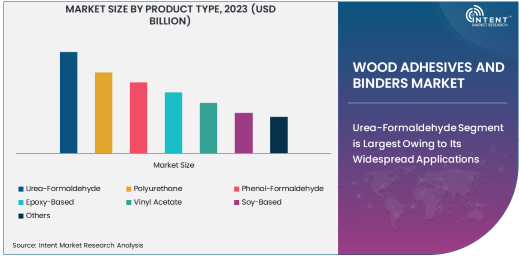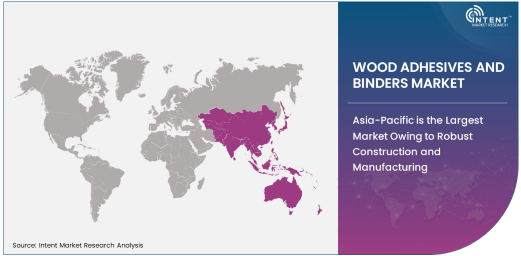As per Intent Market Research, the Wood Adhesives and Binders Market was valued at USD 17.6 billion in 2023 and will surpass USD 25.5 billion by 2030; growing at a CAGR of 5.5% during 2024 - 2030.
The global wood adhesives and binders market is witnessing significant growth, driven by expanding construction activities, increased demand for furniture, and the shift toward sustainable bonding solutions. These products are essential for applications such as flooring, cabinetry, and particleboard, where strong and durable bonding is crucial. Manufacturers are increasingly focusing on eco-friendly and low-VOC formulations to align with regulatory standards and consumer preferences.
Urea-Formaldehyde Segment is Largest Owing to Its Widespread Applications
Urea-formaldehyde dominates the wood adhesives market, attributed to its extensive use in particleboard, plywood, and other wood composite applications. Its cost-effectiveness and strong bonding capabilities make it a preferred choice among manufacturers in the construction and furniture sectors.
This segment's growth is further fueled by the rising demand for engineered wood products, particularly in emerging economies where construction activities are robust. Despite growing concerns about formaldehyde emissions, advancements in low-emission formulations have sustained its market share, maintaining its dominance in large-scale industrial applications.

Furniture Manufacturing is the Fastest Growing Application Segment
The furniture manufacturing segment is experiencing rapid growth, driven by urbanization and changing consumer lifestyles, which have increased demand for modular and aesthetically appealing furniture. Wood adhesives are critical in assembling furniture components, laminates, and veneers.
Additionally, the trend toward lightweight and eco-friendly furniture has accelerated the adoption of advanced adhesive technologies. Bio-based and formaldehyde-free adhesives are gaining popularity in this sector, as manufacturers seek to meet sustainability goals while ensuring product durability and performance.
Residential Construction Emerges as the Largest End-User Industry
Residential construction is the largest end-user segment for wood adhesives and binders, bolstered by the global housing boom and rising home renovation activities. These adhesives are widely used in flooring, cabinetry, and paneling applications in residential settings.
In regions like Asia-Pacific, rapid urbanization and government initiatives supporting affordable housing projects have significantly boosted this segment. As homeowners increasingly prioritize sustainable materials, the adoption of eco-friendly adhesive solutions has further amplified the growth trajectory of this market.
Asia-Pacific is the Largest Market Owing to Robust Construction and Manufacturing
Asia-Pacific leads the wood adhesives and binders market, supported by strong growth in the construction and furniture industries in countries like China, India, and Indonesia. The region’s vast population, rising disposable incomes, and urbanization trends have driven demand for both residential and commercial construction.
Additionally, the presence of key manufacturers and low production costs give this region a competitive edge. Increased government investments in infrastructure development further solidify Asia-Pacific’s position as the largest market for wood adhesives and binders.

Competitive Landscape and Leading Companies
The wood adhesives and binders market is characterized by intense competition, with key players focusing on innovation and sustainability to gain a competitive edge. Companies such as Henkel AG, H.B. Fuller, and BASF SE are at the forefront, offering advanced formulations that meet regulatory standards while delivering superior performance.
Collaborations, acquisitions, and investments in research and development are common strategies among market leaders. The competitive landscape is also witnessing the entry of new players with bio-based adhesives, reflecting the growing importance of sustainability in this dynamic market
Recent Developments:
- Henkel AG launched a new formaldehyde-free adhesive range for sustainable wood applications in December 2023.
- 3M Company acquired a specialty adhesives manufacturer to expand its industrial adhesives portfolio in mid-2024.
- Bostik announced the opening of a new R&D center focused on green adhesives technologies in January 2024.
- Sika AG introduced high-strength, low-VOC wood binders for industrial use in April 2024.
- Dow Inc. collaborated with a leading furniture manufacturer to co-develop bio-based adhesives for eco-friendly furniture lines in June 2024
List of Leading Companies:
- Henkel AG & Co. KGaA
- H.B. Fuller Company
- Ashland Global Holdings Inc.
- Dow Inc.
- BASF SE
- 3M Company
- Huntsman Corporation
- Akzo Nobel N.V.
- Bostik (Arkema Group)
- Sika AG
- Franklin International
- Ashland Global
- Pidilite Industries Ltd.
- Wacker Chemie AG
- Avery Dennison Corporation
Report Scope:
|
Report Features |
Description |
|
Market Size (2023) |
USD 17.6 Billion |
|
Forecasted Value (2030) |
USD 25.5 Billion |
|
CAGR (2024 – 2030) |
5.5% |
|
Base Year for Estimation |
2023 |
|
Historic Year |
2022 |
|
Forecast Period |
2024 – 2030 |
|
Report Coverage |
Market Forecast, Market Dynamics, Competitive Landscape, Recent Developments |
|
Segments Covered |
Wood Adhesives and Binders Market by Product Type (Urea-Formaldehyde, Polyurethane, Phenol-Formaldehyde, Epoxy-Based, Vinyl Acetate, Soy-Based), Application (Furniture Manufacturing, Flooring & Plywood, Cabinetry, Doors & Windows, Particleboard & Fiberboard), End-User Industry (Residential Construction, Commercial Construction, Industrial Applications, Furniture & Interior Design) |
|
Regional Analysis |
North America (US, Canada, Mexico), Europe (Germany, France, UK, Italy, Spain, and Rest of Europe), Asia-Pacific (China, Japan, South Korea, Australia, India, and Rest of Asia-Pacific), Latin America (Brazil, Argentina, and Rest of Latin America), Middle East & Africa (Saudi Arabia, UAE, Rest of Middle East & Africa) |
|
Major Companies |
Henkel AG & Co. KGaA, H.B. Fuller Company, Ashland Global Holdings Inc., Dow Inc., BASF SE, 3M Company, Huntsman Corporation, Akzo Nobel N.V., Bostik (Arkema Group), Sika AG, Franklin International, Ashland Global, Pidilite Industries Ltd., Wacker Chemie AG, Avery Dennison Corporation |
|
Customization Scope |
Customization for segments, region/country-level will be provided. Moreover, additional customization can be done based on the requirements |
|
1. Introduction |
|
1.1. Market Definition |
|
1.2. Scope of the Study |
|
1.3. Research Assumptions |
|
1.4. Study Limitations |
|
2. Research Methodology |
|
2.1. Research Approach |
|
2.1.1. Top-Down Method |
|
2.1.2. Bottom-Up Method |
|
2.1.3. Factor Impact Analysis |
|
2.2. Insights & Data Collection Process |
|
2.2.1. Secondary Research |
|
2.2.2. Primary Research |
|
2.3. Data Mining Process |
|
2.3.1. Data Analysis |
|
2.3.2. Data Validation and Revalidation |
|
2.3.3. Data Triangulation |
|
3. Executive Summary |
|
3.1. Major Markets & Segments |
|
3.2. Highest Growing Regions and Respective Countries |
|
3.3. Impact of Growth Drivers & Inhibitors |
|
3.4. Regulatory Overview by Country |
|
4. Wood Adhesives and Binders Market, by Product Type (Market Size & Forecast: USD Million, 2022 – 2030) |
|
4.1. Urea-Formaldehyde |
|
4.2. Polyurethane |
|
4.3. Phenol-Formaldehyde |
|
4.4. Epoxy-Based |
|
4.5. Vinyl Acetate |
|
4.6. Soy-Based |
|
4.7. Others |
|
5. Wood Adhesives and Binders Market, by Application (Market Size & Forecast: USD Million, 2022 – 2030) |
|
5.1. Furniture Manufacturing |
|
5.2. Flooring & Plywood |
|
5.3. Cabinetry |
|
5.4. Doors & Windows |
|
5.5. Particleboard & Fiberboard |
|
5.6. Others |
|
6. Wood Adhesives and Binders Market, by End-User Industry (Market Size & Forecast: USD Million, 2022 – 2030) |
|
6.1. Residential Construction |
|
6.2. Commercial Construction |
|
6.3. Industrial Applications |
|
6.4. Furniture & Interior Design |
|
6.5. Others |
|
7. Regional Analysis (Market Size & Forecast: USD Million, 2022 – 2030) |
|
7.1. Regional Overview |
|
7.2. North America |
|
7.2.1. Regional Trends & Growth Drivers |
|
7.2.2. Barriers & Challenges |
|
7.2.3. Opportunities |
|
7.2.4. Factor Impact Analysis |
|
7.2.5. Technology Trends |
|
7.2.6. North America Wood Adhesives and Binders Market, by Product Type |
|
7.2.7. North America Wood Adhesives and Binders Market, by Application |
|
7.2.8. North America Wood Adhesives and Binders Market, by End-User Industry |
|
7.2.9. By Country |
|
7.2.9.1. US |
|
7.2.9.1.1. US Wood Adhesives and Binders Market, by Product Type |
|
7.2.9.1.2. US Wood Adhesives and Binders Market, by Application |
|
7.2.9.1.3. US Wood Adhesives and Binders Market, by End-User Industry |
|
7.2.9.2. Canada |
|
7.2.9.3. Mexico |
|
*Similar segmentation will be provided for each region and country |
|
7.3. Europe |
|
7.4. Asia-Pacific |
|
7.5. Latin America |
|
7.6. Middle East & Africa |
|
8. Competitive Landscape |
|
8.1. Overview of the Key Players |
|
8.2. Competitive Ecosystem |
|
8.2.1. Level of Fragmentation |
|
8.2.2. Market Consolidation |
|
8.2.3. Product Innovation |
|
8.3. Company Share Analysis |
|
8.4. Company Benchmarking Matrix |
|
8.4.1. Strategic Overview |
|
8.4.2. Product Innovations |
|
8.5. Start-up Ecosystem |
|
8.6. Strategic Competitive Insights/ Customer Imperatives |
|
8.7. ESG Matrix/ Sustainability Matrix |
|
8.8. Manufacturing Network |
|
8.8.1. Locations |
|
8.8.2. Supply Chain and Logistics |
|
8.8.3. Product Flexibility/Customization |
|
8.8.4. Digital Transformation and Connectivity |
|
8.8.5. Environmental and Regulatory Compliance |
|
8.9. Technology Readiness Level Matrix |
|
8.10. Technology Maturity Curve |
|
8.11. Buying Criteria |
|
9. Company Profiles |
|
9.1. Henkel AG & Co. KGaA |
|
9.1.1. Company Overview |
|
9.1.2. Company Financials |
|
9.1.3. Product/Service Portfolio |
|
9.1.4. Recent Developments |
|
9.1.5. IMR Analysis |
|
*Similar information will be provided for other companies |
|
9.2. H.B. Fuller Company |
|
9.3. Ashland Global Holdings Inc. |
|
9.4. Dow Inc. |
|
9.5. BASF SE |
|
9.6. 3M Company |
|
9.7. Huntsman Corporation |
|
9.8. Akzo Nobel N.V. |
|
9.9. Bostik (Arkema Group) |
|
9.10. Sika AG |
|
9.11. Franklin International |
|
9.12. Ashland Global |
|
9.13. Pidilite Industries Ltd. |
|
9.14. Wacker Chemie AG |
|
9.15. Avery Dennison Corporation |
|
10. Appendix |
A comprehensive market research approach was employed to gather and analyze data on the Wood Adhesives and Binders Market. In the process, the analysis was also done to analyze the parent market and relevant adjacencies to measure the impact of them on the Wood Adhesives and Binders Market. The research methodology encompassed both secondary and primary research techniques, ensuring the accuracy and credibility of the findings.
.jpg)
Secondary Research
Secondary research involved a thorough review of pertinent industry reports, journals, articles, and publications. Additionally, annual reports, press releases, and investor presentations of industry players were scrutinized to gain insights into their market positioning and strategies.
Primary Research
Primary research involved conducting in-depth interviews with industry experts, stakeholders, and market participants across the E-Waste Management ecosystem. The primary research objectives included:
- Validating findings and assumptions derived from secondary research
- Gathering qualitative and quantitative data on market trends, drivers, and challenges
- Understanding the demand-side dynamics, encompassing end-users, component manufacturers, facility providers, and service providers
- Assessing the supply-side landscape, including technological advancements and recent developments
Market Size Assessment
A combination of top-down and bottom-up approaches was utilized to analyze the overall size of the Wood Adhesives and Binders Market. These methods were also employed to assess the size of various subsegments within the market. The market size assessment methodology encompassed the following steps:
- Identification of key industry players and relevant revenues through extensive secondary research
- Determination of the industry's supply chain and market size, in terms of value, through primary and secondary research processes
- Calculation of percentage shares, splits, and breakdowns using secondary sources and verification through primary sources
.jpg)
Data Triangulation
To ensure the accuracy and reliability of the market size, data triangulation was implemented. This involved cross-referencing data from various sources, including demand and supply side factors, market trends, and expert opinions. Additionally, top-down and bottom-up approaches were employed to validate the market size assessment.
NA
